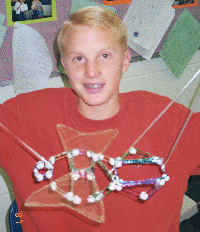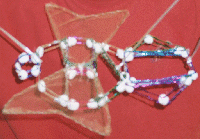I've got that Geometry Bug!
"A Day in the Life of My Geometry Bug"

My Geometry Bug's name is "Poly-Fly." I gave it this name because its
exoskeleton is made up of many different polygons and it is a magnificent sight to see
when it flies! You could stare for hours at my bug when it is in its flight.
My bug has a basic symmetrical shape to it. It has many different polygons that
make up larger shapes. Half circles and hexagons make up the head. A trapezoid,
rectangles, and triangles make up the thorax, which is actually a large octagon. A
rectangle and triangles make up the abdomen, which is a large hexagon. The only part of
my bug that is not symmetrical are the two triangles in the thorax. Everything else is
symmetrical.
My bug has the geometrical shapes that it does because I wanted my bug to have
both a wide thorax and a wide abdomen. So I used a octagon and a hexagon which are
both pretty wide shapes. This way it can consume more food at one point in time and not
have to eat as often.
My bug lives in the deserts of Saudi Arabia. It flies very fast and has been clocked
at speeds of up to 35 miles an hour, so it can get away from almost anything that it wants
to. It gets it energy by sucking out the moisture in the hairs of the camel. When it is not
flying around it will be resting on the back of a camel having a quick meal and then it is
off to more and more flying.
My bug faces a very big geometrical challenge. It only knows the shape which is
a circle. The only way that it flies is in a circle. So if it wants to get to something that is
ten feet in front of him, he has to keep flying in smaller and smaller circles until he
finally reaches his goal. Depending on how far it is from something it can take hours just
to get to something that could be reached in minutes by something that can move in a
straight line or even other shapes, like triangles of rectangles.
The main purpose in my bug's life is to mate with other Poly-Flies and make as
many new babies as it possibly can. One male could impregnate 15 females in one day,
but maybe none of them will survive because the female cannot move while it is
pregnant. So even though millions of new Poly-Flies could be made everyday there
might only be four or five that actually survive. The other purpose in this Bug's life is to
try and be the fastest Poly-Fly in its territory. The faster you fly the higher up you will
be in rank. If you are the fastest then you are the "King" Poly-Fly. This is a great honor
because it means that you have the privilege of mating with the "Queen", which has a 100
percent chance of birth rate survival because while the queen is pregnant every Poly-Fly
comes to protect it and make sure that a new heir to the "throne" is born.
A Poly-Flie's life span is about 10 years. It is a very hard bug to be caught and
killed. The only time this can happen is either when it is consuming energy or when it is
mating. Both activities take about 30 seconds to a minute so there is very little time for
the bug to be caught.
If only they could learn to fly in a different shape then they might be the most
magnificent species ever created (after humans of course.)
BY MARK LIENHART THE SMARTEST MATH STUDENT IN BLOOMINGTON, ILLINOIS

Project
Description
Research
Questions
Student Work
|